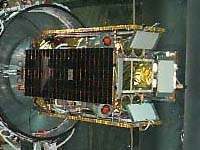HETE
High Energy Transient Experiment
 The High Energy Transient Experiment (HETE) is an international mission led by The Massachusetts Institute of Technology (MIT). Its prime objective is to carry out the first multiwavelength study of gamma ray bursts (GRBs) with UV, X-ray, and gamma ray instruments. A unique feature of the mission is its capability to localize bursts with several arcsecond accuracy, in near real-time aboard the spacecraft. These positions are transmitted to the ground, and picked up by a global network of primary and secondary ground stations (SGS), enabling sensitive follow-up studies.
The High Energy Transient Experiment (HETE) is an international mission led by The Massachusetts Institute of Technology (MIT). Its prime objective is to carry out the first multiwavelength study of gamma ray bursts (GRBs) with UV, X-ray, and gamma ray instruments. A unique feature of the mission is its capability to localize bursts with several arcsecond accuracy, in near real-time aboard the spacecraft. These positions are transmitted to the ground, and picked up by a global network of primary and secondary ground stations (SGS), enabling sensitive follow-up studies.
Spacecraft
HETE is a sun pointing, Momentum biased spacecraft with attitude controlled to +/- 2 degrees by magnetic torque coils. Actual spacecraft attitude can be determined to within +/- 30 arcminutes with onboard sensors. HETE's multi-processor architecture runs at 80 VAX MIPS with 96 MBytes of EDAC mass memory available for data buffering. Telemetry can be sent/received from three primary ground stations located in Haystack, Mass., Miyazaki, Japan, and Tolouse, France. S-band uplink is designed for 31.25 kbit/s throughput at 2.092 GHz. Downlink is designed for 250 kbit/s at 2.272 GHz. A network of receive-only secondary ground stations are designed to immediately alert researchers to transient outbursts, thus increasing the chance of observing the event with ground-based telescopes. Transmission occurs in the VHF at 137.9622 MHz. The VHF link can also transmit spacecraft telemetry in the event of an onboard emergency.
Payload
HETE provides multiwavelength coverage of high energy transients with three different instruments. Each is capable of operating independently of the other, but during orbit night, when all three instruments operate, the detection of a transient by one instrument will result in collection of data in all three energy bands.
The French Gamma Telescope (FREGATE) handles the detection and spectroscopy of gamma-ray bursts and monitors variable X-ray sources.
The Wide-Field X-Ray Monitor (WXM), built by a team of Japanese and U.S. Scientists from Riken and Los Alamos National Labs is the prime instrument for detecting X-ray sources.
Four Ultraviolet CCD cameras were built by MIT's Center for Space Research. Three are of identical design, one has an optical filter. In addition to providing the most accurate directional information about transient events, the UV cameras assist with spacecraft attitude determination. The 1024x1024 pixel CCD's were fabricated by MIT's Lincoln Labs.
HETE hardware and software have been designed to allow the satellite to operate with virtually no commands from the ground. All instruments can be configured to allow for completely autonomous observations, using on board sensors to determine safe and appropriate operational conditions.
Status as of 3/31/97
The HETE spacecraft reached a nominal orbit on Nov. 4, along with its piggybacked partner, SAC-B. However, the two spacecraft were not ejected from the Orbital Sciences Corporation Pegasus XL rocket as planned. Telemetry indicated a power failure in the transient power bus of the Pegasus third stage, causing the failure of 3 crucial pyrotechnics to ignite. Thus, HETE remained enclosed in OSC's Dual Payload Attachment Fitting (DPAF).
On the morning of Nov. 5, operators of a 23m VHF antenna at Wallops Island did receive a transmission while monitoring a frequency used by HETE's emergency beacon. The modulation and duty cycle were correct. Subsequent passes at Los Alamos National Lab and Wallops Island also picked up a similar though much weaker signal. Unable to deploy solar panels to charge it's batteries, the HETE spacecraft expired several days after launch.
The relevance of the HETE mission has not been diminished since the loss of the satellite. The resolution of the mystery of Gamma ray bursts remains a high priority in X-ray astronomy, and the resurrection of HETE in the immediate future is a course being actively pursued by the HETE team.
| Country of Origin | NASA |
| Customer/User | MIT Center for Space Research |
| Manufacturer(s) | AeroAstro, LLC |
| Size | Body fits within cylinder 89cm X 66 cm dia. 4 small solar panels deploy in flight. |
| Orbit | 540 km circular, 38 degree inclination |
| Design Life | 6 months, nothing to preclude 18 months |
| Related Sites | HETE Home Page |
Launch Facts
| Name | Int'l Desig. | Date | Site | Vehicle | Orbit | Mass(kg) |
| Notes | ||||||
| HETE | 1996-061A | 11/4/96 | Wallops | Pegasus XL | LEO | 128 |
| Was not ejected from launch vehicle rendering spacecraft useless; still attached to SAC-B and Pegasus upper stage; now being tracked as a single 650kg object. | ||||||
Information in The Mission and Spacecraft Library is provided without warranty or guarantee. USE AT YOUR OWN RISK.